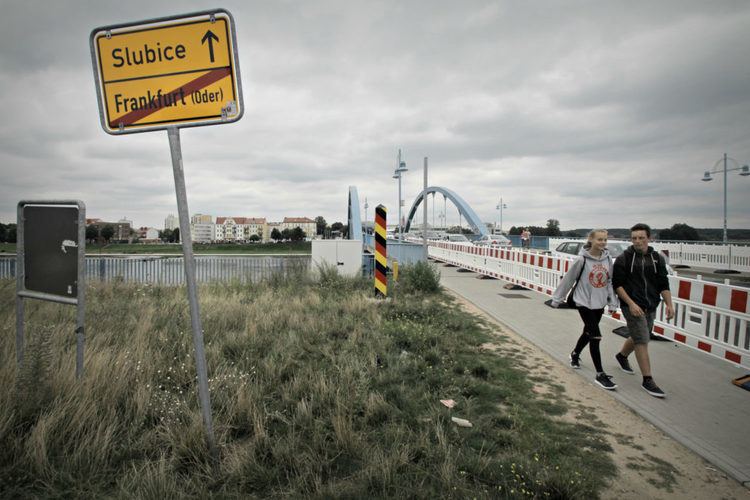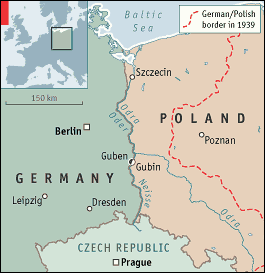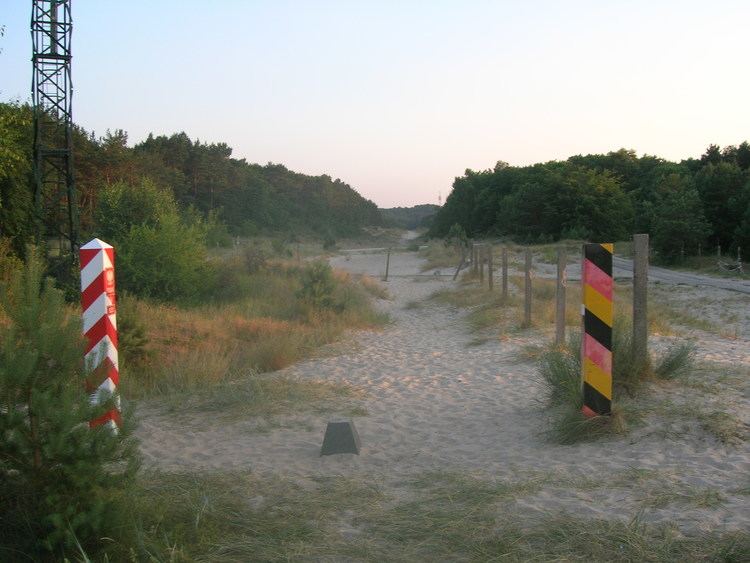 | ||
The Germany–Poland border (German: Grenze zwischen Deutschland und Polen, Polish: Granica polsko-niemiecka), the state border between Poland and Germany, is currently the Oder–Neisse line. It has a total length of 467 km (290 mi) and has been in place since 1945. It stretches from the Baltic Sea in the north to the Czech Republic in the south. Nevertheless, the border has not always followed this line, and it has a long and often volatile history.
History

The Germany–Poland border traces its origins to the very beginnings of the Polish state, with the Oder (Odra) and Neisse (Nysa) rivers (the Oder–Neisse Line) being one of the earliest natural boundaries between Germany and the Slavic tribes. Over several centuries, it has moved eastwards, stabilized in the 14th century, and disappeared in the late 18th century with the partitions of Poland, in which Poland's neighbors, including the Kingdom of Prussia, annexed all of its territory. In 1871 Prussia became part of the German Empire.

After Poland regained independence following World War I and the 123 years of partitions, a long German-Polish border was settled on, 1,912 km (1,188 mi) long (including a 607 km (377 mi) border with East Prussia). The border was partially shaped by the Treaty of Versailles and partially by plebiscites (East Prussian plebiscite and the Silesian plebiscite, the former also affected by the Silesian Uprisings). The shape of that border roughly resembled that of pre-partition Poland.

After World War II, the border was drawn from Świnoujście (Swinemünde) in the north at the Baltic Sea southward to the Czech Republic (then part of Czechoslovakia) border with Poland and Germany near Zittau. It follows the Oder–Neisse Line of the Oder (Odra) and Neisse (Nysa) rivers through most of their course.‹See TfD› This was agreed upon by the main Allies of World War II – USSR, USA and UK, at the Soviets' insistence, and, without any significant consultations with Poland (or Germany), at the Yalta Conference and Potsdam Conference. This border was a compensation to Poland for territories lost to the Soviet Union as a consequence of the Molotov–Ribbentrop Pact, and resulted in significant westward transfers of German population from the Recovered Territories, matching the Polish population transfers from the Kresy territories. It roughly matched the centuries-old, historical border between the Medieval Polish and German states. It divided several river cities into two parts – Görlitz/Zgorzelec, Guben/Gubin, Frankfurt (Oder)/Słubice, Bad Muskau/Łęknica.
The border was recognized by East Germany in the Treaty of Zgorzelec in 1950, by West Germany in 1970 in the Treaty of Warsaw, and by reunified Germany, in 1990 in the German–Polish Border Treaty of 1990. It was subject to minor corrections (land swaps) in 1951. The borders were partially open from 1971 to 1980, when Poles and East Germans could cross it without a passport or a visa; it was however closed again after few years, due to economic pressure on the East German economy from Polish shoppers and the desire of the East German government to diminish the influence of the Polish Solidarity movement on East Germany.
Following the fall of communism in Poland and Germany, and the German reunification, the border became part of the eastern border of the European Community, then that of the European Union. For a period, it was "the most heavily policed border in Europe". After Poland joined the European Union in 2004, the border controls were relaxed in agreement with the Schengen Agreement to eliminate passport controls by 2007. The modern borderlands of Poland and Germany are inhabited by about one million of those countries' citizens within the counties on each side.
